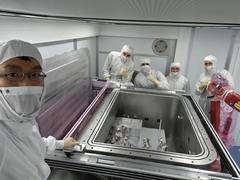URL: https://www.desy.de/news/news_search/index_eng.html
Breadcrumb Navigation
DESY News: ALPS II achieves world record
News
News from the DESY research centre
ALPS II achieves world record
DESY’s very own dark-matter experiment ALPS II – for “Any Light Particle Search” – hasn’t even started up yet, but is already breaking world records. The team, whose experiment sits in the tunnel of the former HERA accelerator and uses upcycled HERA magnets to (hopefully) send light through a wall, has managed to store laser light for 6.75 milliseconds. “We believe this a world record for the longest amount of time laser light spends circulating between two mirrors,“ says ALPS II researcher Todd Kozlowski, PhD student of the University of Florida. “This clearly demonstrates the great performance of our optics control system, the environmental stability of our experimental site, and the high quality of our optics.” This record is a milestone on the way towards starting up the experiment in a few months’ time. The PVLAS experiment for quantum electrodynamics in Italy held the previous world record with 5,4 milliseconds.

Members of the ALPS Optics and Engineering working groups after successfully installing the central optical breadboard - a key component of the ALPS II experiment - into its vacuum enclosure. From left to right): Li-Wei Wei (optics), Sandy Croatto (engineering), Todd Kozlowski (optics), Aaron Spector (optics), and David Reuther (engineering). Image: DESY
The concept is that in a strong magnetic field, photons – particles of light – could transform into axions andvice versa. The first section of the HERA magnets, arranged in a straight line, encloses a vacuum tube in which high-intensity laser light is reflected back and forth in mirror cavity. If a photon were to transform into an axion, it could pass through a wall located at the centre of the two magnet strings. Behind it, this axion could change back into light, again in a mirror cavity, in the second magnetic string with roughly the same setup.
The mirror cavities amplify the light from the laser to heighten the chance of one of the photons transforming into an axion. However, it’s not a matter of just shooting a laser beam into any mirroring space and hoping something might happen. This record light storage time is only possible with extremely high-quality mirrors polished to microscopic smoothness and coated with special dielectric layers to reflect nearly all of the light. A single photon travels around 2000 km while it stored in the cavity for just over six milliseconds.
Moreover, the relative lengths of the two mirror cavities must be controlled to an accuracy smaller than the diameter of an atom so that they are absolutely equal. The team had to develop a system to ultra-fine-tune the mirrors to reach just the right resonance frequency. “We’ve spent the last ten years working on this,” ALPS scientist Aaron Spector, leader of the optics team, explains. “An experiment of this scale has never been attempted before, so we had to start with no experience.” Over the course of time, the team have become world leaders in long-baseline high-precision interferometry.
Ultimately, the storage time will be extended to between 12 and 15 milliseconds. “We're still about a factor of 50% below our target. So you can imagine that the design of the experiment calls for some very high quality mirrors and strict handling procedures,” Kozlowski says. ALPS II is set to start first data-taking in early 2023.
Dark matter
Dark matter is one of the greatest mysteries in physics. Observations and calculations of the motion of stars in galaxies, for example, show that there must be more matter in the Universe than we can account for with matter particles known today. In fact, dark matter must make up 85 % of all the matter in the Universe. However, currently we don’t know what it is. But we know that it does not interact with regular matter and is essentially invisible, so that it is called “dark”.
There are several theories that try to explain the nature of dark matter and the particles it may consist of. One of these theories states that dark matter consists of very light-weight particles with very specific properties. One example is the axion which was originally postulated to explain aspects of the strong interaction, one of the fundamental forces of nature. There are also puzzling astrophysical observations such as discrepancies inthe evolution of stellar systems, which might also be explained by the existence of axions or axion-like particles.



